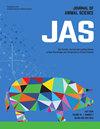PS-16糖原源对奶牛繁殖性能的影响
IF 2.9
2区 农林科学
Q1 AGRICULTURE, DAIRY & ANIMAL SCIENCE
引用次数: 0
摘要
本研究的目的是确定饲粮中增加糖原潜势(GP)对放牧原生地的3月产犊期奶牛繁殖性能、产奶量和犊牛生产性能的影响。在一项为期3年的研究中,253头产后奶牛(2岁和3岁)被随机分配到四种补充治疗中的一种:1) 910 g / d的干酒糟的谷物与可溶性估计GP (DDGS) 67克、2)908 g / d DDGS + 40 g / d的丙酸盐(100年NutroCal Kemin动物营养和健康),估计GP (PS) 97克、3)800 g / d DDGS + 136 g / d的猪血粉估计有97 g的GP (BM1)和4)691 g / d DDGS + 265 g的猪血粉估计有126 g (GP (BM2)。试验旨在通过提高瘤胃不可降解蛋白水平或直接提供瘤胃丙酸来源来提高GP水平。每组饲料平均饲喂98 d。数据采用SAS混合程序进行分析。在整个研究过程中,产后补充策略对奶牛体重(BW)没有影响(P≥0.66)。此外,产后补充策略对体况评分无影响(P≥0.31)。犊牛出生和孕前体重不受产后添加量的影响(P≥0.66)。断奶犊牛体重表现出乳龄互作处理(P <;0.01), 2岁犊牛体重无差异(P≥0.24);3岁犊牛断奶时体重增加(P≤0.02)。同样,产奶量也受到奶牛年龄相互作用的影响(P <;0.01), 2龄奶牛产奶量无显著差异(P = 0.11);然而,3岁喂养的PS与3岁喂养的PS相比,产奶量有所增加。乳成分(蛋白质、脂肪、乳糖、非脂肪固体)不受产后补充策略的影响(P≥0.21)。然而,乳尿素氮有受日粮产糖潜能影响的趋势(P = 0.09)。PS饲喂奶牛的妊娠率最高(P = 0.05),与其他产后添加物无显著差异(P≥0.75)。本研究结果表明,与增加瘤胃不可降解蛋白产生的总糖原电位相比,瘤胃后糖原电位来源(促糖AA vs丙酸)对繁殖和犊牛生产性能的影响更大。本文章由计算机程序翻译,如有差异,请以英文原文为准。
PS-16 Glucogenic precursor source impacts reproductive performance in young range cows
The objective of this study was to determine the impact of increasing supplemental glucogenic potential (GP) of the diet on reproductive performance, milk production, and calf performance in young March-calving range cow grazing native range. In a 3-yr study, 253 postpartum range cows (2-and 3-yr-old) were randomly assigned to one of four supplementation treatments: 1) 910 g/d of dried distillers grains with solubles with an estimated GP of 67 g (DDGS), 2) 908 g/d of DDGS plus 40 g/d of propionate salt (NutroCal 100, Kemin Animal Nutrition and Health) with an estimated GP of 97 g (PS), 3) 800 g/d of DDGS plus 136 g/d of porcine blood meal with an estimated 97 g of GP (BM1), and 4) 691 g/d of DDGS plus 265 g of porcine blood meal with an estimated 126 g of GP (BM2). Treatments were designed to provide increasing levels of GP from either increasing levels of rumen undegradable protein or a direct ruminal propionate source. Supplements were individually fed for an average of 98 d. Data were analyzed with the Mixed procedure of SAS. Postpartum supplementation strategy did not influence (P ≥ 0.66) cow body weight (BW) during the entire study. In addition, body condition score was not influenced (P ≥ 0.31) by postpartum supplementation strategy. Calf BW at birth and pre-breeding were not influenced (P ≥ 0.66) by their dams’ postpartum supplementation. Calf BW at weaning exhibited a treatment by cow age interaction (P < 0.01) with no differences (P ≥ 0.24) in calf BW in calves from 2-yr-old dam; however, 3-yr-old cows fed PS had increased (P ≤ 0.02) calf BW at weaning. Similarly, milk production exhibited a treatment by cow age interaction (P < 0.01) where milk production was not different (P = 0.11) among 2-yr-old cows; however, milk production was increased in 3-year-old fed PS compared their 3-yr-old counterparts. Milk components (protein, fat, lactose, solids non-fat) were not influenced (P ≥ 0.21) by postpartum supplementation strategy. However, milk urea nitrogen had a tendency (P = 0.09) to be influenced by glucogenic potential of the diet. Pregnancy rate was the greatest (P = 0.05) in PS fed cows with no differences (P ≥ 0.75) among the other postpartum supplements. The results of this study indicate that the source of post ruminal glucose potential (glucogenic AA vs propionate) has a larger impact on reproduction and cow-calf performance than overall glucogenic potential coming from increasing rumen undegradable protein.
求助全文
通过发布文献求助,成功后即可免费获取论文全文。
去求助
来源期刊

Journal of animal science
农林科学-奶制品与动物科学
CiteScore
4.80
自引率
12.10%
发文量
1589
审稿时长
3 months
期刊介绍:
The Journal of Animal Science (JAS) is the premier journal for animal science and serves as the leading source of new knowledge and perspective in this area. JAS publishes more than 500 fully reviewed research articles, invited reviews, technical notes, and letters to the editor each year.
Articles published in JAS encompass a broad range of research topics in animal production and fundamental aspects of genetics, nutrition, physiology, and preparation and utilization of animal products. Articles typically report research with beef cattle, companion animals, goats, horses, pigs, and sheep; however, studies involving other farm animals, aquatic and wildlife species, and laboratory animal species that address fundamental questions related to livestock and companion animal biology will be considered for publication.
 求助内容:
求助内容: 应助结果提醒方式:
应助结果提醒方式:


